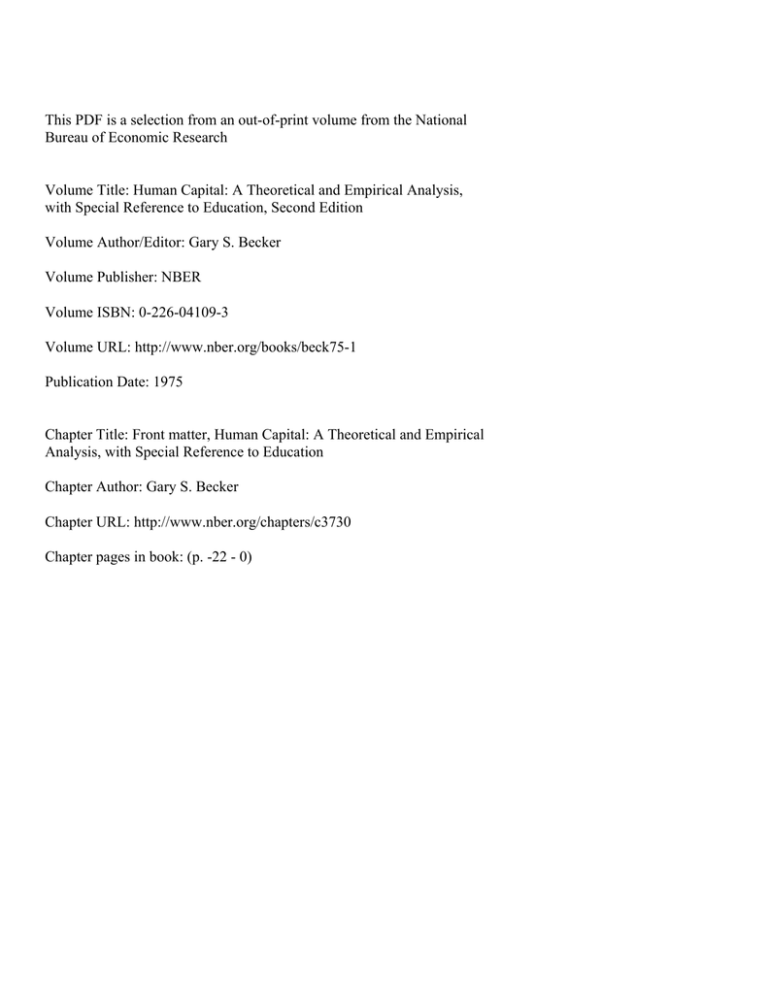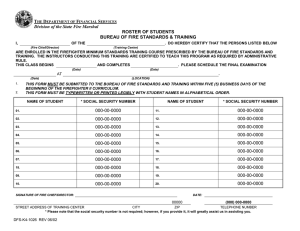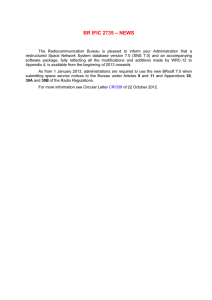
This PDF is a selection from an out-of-print volume from the National
Bureau of Economic Research
Volume Title: Human Capital: A Theoretical and Empirical Analysis,
with Special Reference to Education, Second Edition
Volume Author/Editor: Gary S. Becker
Volume Publisher: NBER
Volume ISBN: 0-226-04109-3
Volume URL: http://www.nber.org/books/beck75-1
Publication Date: 1975
Chapter Title: Front matter, Human Capital: A Theoretical and Empirical
Analysis, with Special Reference to Education
Chapter Author: Gary S. Becker
Chapter URL: http://www.nber.org/chapters/c3730
Chapter pages in book: (p. -22 - 0)
HUMAN CAPITAL
A Theoretical and Empirical Analysis,
with Special Reference to Education
National Bureau of Economic Research
Human Behavior and Social Institutions
1. Essays in the Economics of Health and Medical Care,
Victor R. Fuchs, Editor
2. Schooling, Experience, and Earnings, by Jacob Mincer
3. Essays in the Economics of Crime and Punishment,
Gary S. Becker and William M. Landes, Editors
4. Income Inequality: Regional Analyses within a Human Capital
Framework, by Barry R. Chiswick
5. Human Capital, 2nd Edition, by Gary S. Becker
(For 1st Edition, see General Series No. 80)
Human Capital
A THEORETICAL AND EMPIRICAL ANALYSIS,
WITH SPECIAL REFERENCE TO EDUCATION
SECOND EDITION
BY
GARY S. BECKER
University of Chicago
PUBLISHED BY
NATIONAL BUREAU OF ECONOMIC RESEARCH
NEW YORK
Distributed by
Columbia University Press
New York and London
1975
Copyright © 1975 by the National Bureau of Economic Research, Inc.
All Rights Reserved
Library of Congress card no. 64—7748 (1st edition)
74-83469 (2nd edition)
ISBN: 0—87014—513—4
Printed in the United States of America
2051090
Becker, Gary Stanley.
Human Capital
a theoretical and empirical analysis, with special reference to education / by Gary S. Becker. -- 2d ed. -- New
York:National Bureau of Economic Research:
distributed by Columbia University Press,
:
1975.
LB2321.B27
74-83469
TI
—
—
-
NATIONAL BUREAU OF ECONOMIC RESEARCH
OFFICERS
Edwin Kuh, Director, Computer Research
Arthur F. Burns, Honorary Chairman
Walter W. Heller, Chairman
J. Wilson Newman, Vice Chairman
John R. Meyer, President
Thomas D. Flynn. Treasurer
Douglas H. Eldridge, Vice President-
Center
Hal B. Lary, Vice President-Research
Robert E. Lipsey, Vice President-Research
Sherman J. Maisel, Co-director NBER.West
Geoffrey H. Moore, Vice President-Research
Edward K. Smith, Vice President
Executive Secretary
Victor R. Fuchs, Vice President-Research;
Co-director NBER-West
DIRECTORS AT LARGE
J. Irwin Miller, Cummins Engine Company,
Atherton Bean, International Multifoods
Inc.
Corporation
Geoffrey H. Moore, National Bureau of
Joseph A. Beirne, Communications
Economic Research
Workers of America
Bradstreet, Inc.
J. Wilson Newman, Dun
Arthur F. Burns, Board of Governors of
United States Trust
the Federal Reserve System
James J.
Company of New York
Wallace J. Campbell, Foundation for
Alice M. Rivlin, Brookings Institution
Cooperarive Housing
Robert V. Roosa, Brown Brothers Harriman
Erwin D. Canham, Christian Science
Co.
Monitor
Boris Shishkin, Washington, D.C.
Emilio G. Collado, Exxon Corporation
Arnold M. Soloway, Jamaicaway Tower,
Solomon Fabricant, New York University
Boslon, Massachusetts
Eugene P. Foley, Montrose Securities, Inc.
Lazare Teper, International Ladies' Garment
David L. Grove, International Business
Workers' Union
Machines Corporation
Donald B. Woodward, Riverside, Connecticut
Walter W. Heller, University of Minnesota
Theodore 0. Yntema, Oakland University
Vivian W. Henderson, Clark College
John R. Meyer, Harvard University
DIRECTORS BY UNIVERSITY APPOINTMENT
Maurice W. Lee, North Carolina
Gardner Ackley, Michigan
Almarin Phillips. Pennsylvania
Lloyd G. Reynolds, Yale
Charles H. Berry, Princeton
Francis M. Boddy, Minnesota
Robert M. Solow, Massachusetts Institute of
Otto Eckstein, Harvard
Technology
Walter D. Fisher, Northwestern
Henri Theil, Chicago
R. A. Gordon, California
William S. Vickrey, Columbia
Robert J. Lampman, Wisconsin
Thomas A. Wilson, Toronto
Moses Abramovitz, Stanford
DIRECTORS BY APPOINTMENT OF OTHER ORGANIZATIONS
Eugene A. Birnbaum, American Management
Philip M. Klutznick, Committee for
Association
Economic Development
Thomas D. Flynn, American Institute of
Roy E. Moor, National Association of
Certified Public Accountants
Business Economists
Nathaniel Goidlinger, American Federation
Douglass C. North, Economic History
of Labor and Congress of Industrial
Association
Organizations
Willard L. Thorp, American Economic
Harold G. Haicrow, American Agricultural
Association
Economics Association
W. Allen Wallis, American Statistical
Walter E. Hoadley, American Finance
Association
Association
Robert M. Will, Canadian Economics
-
Association
Percival F. Brundage
Frank W. Fetter
Gottfried Haberler
Gary S. Becker
Charlotte Boschan
Phillip Cagan
Stanley Diller
Solomon Fabricant
Milton Friedman
Gary Fromm
Victor R. Fuchs
J. Royce Gion
DIRECTORS EMERITI
Albert J. Hettinger, Jr.
George B. Roberts
Murray Shields
Joseph H. Willics
SENIOR RESEARCH STAFF
Raymond W. Goldsmith Hal B. Lary
Michael Gort
Robert E. Lipsey
Michael Grossman
Sherman J. Maisel
F. Thomas Juster
John F. Rain
John W. Kendrick
Irving B. Kravis
Edwin Kuh
William M. Landes
Benoit B. Mandelbrot
John R. Meyer
Robert T. Michael
Jacob Mincer
Ilse Mintz
Geoffrey H. Moore
M. Ishaq Nadiri
Nancy Ruggles
Richard Ruggles
Anna J. Schwartz
Robert P. Shay
Edward K. Smith
George J. Stigler
Victor Zarnowitz
S
Relation of the Directors
to the Work and Publications
of the
National Bureau of Economic Research
1. The object of the National Bureau of Economic Research is to ascertain and to present to
the public important economic facts and their interpretation in a scientific and impartial manner. The Board of Directors is charged with the responsibility of ensuring that the work of the
National Bureau is carried on in strict conformity with this object.
2. The President of the National Bureau shall submit to the Board of Directors, or to its
Executive Committee, for their formal adoption all specific proposals for research to be instituted.
3. No research report shall be published until the President shall have submitted to each
member of the Board the manuscript proposed for publication, and such information as will,
in his opinion and in the opinion of the author, serve to determine the suitability of the
report for publication in accordance with the principles of the National Bureau. Each manuscript shall contain a summary drawing attention to the nature and treatment of the problem
studied, the character of the data and their utilization in the report, and the main condusions
reached.
4. For each manuscript so submitted, a special committee of the Directors (including Directors Emeriti) shall be appointed by majority agreement of the President and Vice Presidents (or
by the Executive Committee in case of inability to decide on the part of the President and Vice
Presidents), consisting of three Directors selected as nearly as may be one from each general
division of the Board. The names of the special manuscript committee shall be stated to each
Director when the manuscript is submitted to him. It shall be the duty of each member of the
special manuscript committee to read the manuscript. If each member of the manuscript committee signifies his approval within thirty days of the transmittal of the manuscript, the report
may be published. If at the end of that period any member of the manuscript committee withholds
his approval, the President shall then notify each member of the Board, requesting approval or
disapproval of publication, and thirty days additional shall be granted for this purpose. The
manuscript shall then not be published unless at least a majority of the entire Board who shall
have voted on the proposal within the time fixed for the receipt of votes shall have approved.
5. No manuscript may be published, though approved by each member of the special manuscript committee, until forty-five days have elapsed from the transmittal of the report in manuscript form. The interval is allowed for the receipt of any memorandum of dissent or reservation, together. with a brief statement of his reasons, that any member may wish to express; and
such memorandum of dissent or reservation shall be published with the manuscript if he so
desires.
Publication does not, however, imply that each member of the Board has read the
manuscript, or that either members of the Board in general or the special committee have passed
on its validity in every detail.
6. Publications of the National Bureau issued for informational purposes concerning the work
of the Bureau and its staff, or issued to inform the public of activities of Bureau staff, and vol.
umes issued as a result of various conferences involving the National Bureau shall contain a
disclaimer noting that such publication has not passed through the normal review procedures required in this resolution. The Executive Committee of the Board is charged with
review of all such publications from time to time to ensure that they do not take ott the character of formal research reports of the National Bureau, requiring formal Board approval.
7. Unless otherwise determined by the Board or exempted by the terms of paragraph 6, a copy
of this resolution shall be printed in each National Bureau publication.
(Resolution adopted October 25, 1926, and revised February 6, 1933,
February 24, 1941, April 20, 1968, and September 17, 1973)
The first edition of this study was
made possible by funds granted
by the Carnegie Corporation of
New York to the National Bureau. The Carnegie Corporation
is, however, not to be understood
as approving or disapproving by
virtue of its grant any of the state-
ments made or views expressed
herein.
Preface to the First Edition
The origin of this study can be traced both to the finding that a substantial growth in income in the United States remains after the growth
in physical capital and labor has been accounted for and to the emphasis of some economists on the importance of education in promoting
economic development. My original intention was to shed some exploratory light on these issues by bringing together readily available information from Census reports on the incomes of persons with different
amounts of education and from the Office of Education on the costs of
education. For if education were economically important, I reasoned,
money rates of return on education ought to be significant.
A long time has elapsed between the start, back in 1957, and the ap-
pearance of this monograph presenting the full analysis. During that
time interest in the economics of education has mushroomed throughout the world and stimulated a profusion of research and policy proposals. Estimates have been made of the amounts invested in and the
rates of return on education in both rich and poor countries. Perhaps
some of the expanding interest can be traced to preliminary reports on
the National Bureau study.l
This interest and further reflection, in turn, encouraged me to transform the original aim into a more ambitious undertaking. I became
1 The previously published reports consist of "Underinvestment in College Education?" in American Economic Review, May 1960, and "Investment in Human Capital:
A Theoretical Analysis," Investment in Human Beings, NBER Special Conference 15,
supplement to Journal of Political Economy, October 1962.
PREFACE
1X
interested in the general theory of investment in human capital with
its ramifications for a variety of economic phenomena. The theoretical
analysis in turn led to an empirical examination of several other effects
of education, such as those centering around the shapes of age-earnings
and age-wealth profiles. Finally, the discussion of rates of return covers
a wider variety of evidence, groups, time periods, and implications than
in other studies.
Support, assistance, and criticism were generously provided by many
institutions and persons during the course of this study. Let me first
thank the Carnegie Corporation of New York for their two grants to
the National Bureau to explore work on the economic effects of education. Leave from teaching duties was provided by the Ford Professorship at Columbia University during the academic year 1960—1961, and
a Ford Faculty Fellowship during 196S—1964.
The study would have been impossible without the aid of a series of
unusually able and conscientious research assistants. Major contributions were made by Rosanne Cole, Linda Kee, and Eugenia Scandrett,
with additional assistance from Mary Holman Faden, Shirley Johnson,
and June Cohn.
T. W. Schultz, the major figure in the economics of education, has
been liberal with encouragement and most helpful with criticism. I feel
greatly indebted to him, and would like to record my appredation here.
Jacob Mincer has been exceedingly helpful in countless discussions and
on numerous drafts with suggestions, criticisms, and that intangible
asset—enthusiasm.
The National Bureau reading committee played an important role
in improving the content. I am indebted to George J. Stigler, Richard
Easterlin, Albert Fishlow, Milton Friedman, and Zvi Griliches. Many
others commented on all or parts of various drafts. I would like to
acknowledge the helpful contributions of M. Blaug, Arthur F. Burns,
Edward F. Denison, Evsey Domar, Solomon Fabricant, Victor R. Fuchs,
Leo Goodman, W. Lee Hansen, Hendrick Houthakker, C. Harry Kahn,
James N. Morgan, Selma Mushkin, Alice Rivlin, and of various participants in the Labor Workshop at Columbia University. Members of
the National Bureau Board of Directors who provided useful comments were V. W. Bladen, Marion B. Folsom, W. Allen Wallis, and
Joseph H. Willits.
I am grateful to the editorial staff of the National Bureau, especially
to Marie-Christine Culbert for her detailed and incisive comments.
H. Irving Forman skillfully drew the charts.
To my wife Doria
For encouragement and support during
a long period of production
Contents
I.
PREFACE TO THE FIRST EDITION
INTRODUCTION TO THE SECOND EDITION
INTRODUCTION TO THE FIRST EDITION
Viii
I
9
Part One: Theoretical Analysis
II.
INVESTMENT IN HUMAN CAPITAL: EFFECTS ON EARNINGS
1.
2.
3.
III.
4.
On-the-Job Training
General Training
Specific Training
Schooling
Other Knowledge
Productive Wage Increases
INVESTMENT IN HUMAN CAPITAL: RATES OF RETURN
1.
2.
3.
Relation between Earnings, Costs, and Rates of Return
Addendum: The Allocation of Time and Goods over
Time
The Incentive to Invest
Number of Periods
Wage Differentials and Secular Changes
Risk and Liquidity
Capital Markets and Knowledge
Some Effects of Human Capital
Examples
15
16
19
26
37
39
40
45
45
56
71
71
75
77
78
81
81
Xli
CONTENTS
Ability and the Distribution of Earnings
Addendum: Education and the Distribution of Earnings: A Statistical Formulation
Addendum: Human Capital and the Personal Distribution of Income: An Analytical Approach
Supplement: Estimating the Effect of Family Background on Earnings
83
88
94
117
Part Two: Empirical Analysis
IV.
RATES OF RETURN FROM COLLEGE EDUCATION
1.
Money Rates of Return to White Male College
Graduates
Returns in 1939
Costs in 1939
V.
Rates of Return in 1939
Rates of Return in 1949
2. Some Conceptual Difficulties
Correlation between "Ability" and Education
Correlation between Education and Other Human
Capital
3. Rates of Return to Other College Persons
College Dropouts
Nonwhites
Women
Rural Persons
4. Variation in Rates of Return
UNDERINVESTMENT IN COLLEGE EDUCATION?
1.
VI.
1.
2.
VII.
The Rate of Return from High School Education
Trends in Rates of Return
After 1939
Before 1939
AGE, EARNINGS, WEALTH, AND HUMAN CAPITAL
1.
VIII.
Private Money Gains
2. Social Productivity Gains
3. Private Real Rates
RATES OF RETURN FROM HIGH SCHOOL EDUCATION
AND TRENDS OVER TIME
2.
Age-Earnings Profiles
Age-Wealth Profiles
SUMMARY AND CONCLUSIONS
147
148
148
152
154
155
157
157
167
169
169
172
178
180
181
191
191
194
198
201
201
205
205
209
214
216
223
231
Xlii
CONTENTS
1.
2.
3.
Summary
231
Future Research
Concluding Comments
234
237
Appendixes
A.
1.
2.
B.
238
238
238
241
242
244
SOURCES AND METHODS
Incomes
a. The Basic Data
b. Under- and Overreporting
c. Unemployment
d. Coverage in 1939
e. Taxes
f. Urban-Rural Distribution
g. Hours of Work
Costs
a. Earnings of Students
b. Direct Private Costs
c. Direct Social Costs
-
245
247
247
248
248
251
254
MATHEMATICAL DISCUSSION OF RELATION
BETWEEN AGE, EARNINGS, AND WEALTH
257
INDEX
264
Tables
1.
2.
3.
4.
5.
6.
7.
8.
Results of Regressing Natural Log of Earnings on Education for 1959 Earnings of White Males Aged 25 to 64 in
the South and Non-South
92
Actual Earning Differentials between Urban, Native
White, Male College and High School Graduates in 1939
at Various Ages
150
Alternative Estimates of Rates of Return to 1939 Cohort
of Native White Male College Graduates
155
Earning Differentials between White Male College and
High School Graduates in 1949 at Various Ages
156
Several Measures of Ability at Different Educational
Levels in the 1950s
158
Mean Salaries of Illinois, Minnesota, and Rochester Men,
by Rank in High School Graduating Class and by Intelligence Test Score
162
Average and Marginal Market Discrimination against
Nonwhites for Various Age and Education Classes, by
Region, 1939
175
Family Incomes of Married Men and Women in 1960, by
Education and Years after First Job
180
xvi
TABLES
9.
10.
11.
12.
Coefficients of Variation in After-Tax Income of White
Males, by Age and Years of Education, 1939 and 1949
Coefficients of Variation in Mortality and Cohort Incomes
for College and High School Graduates, by Age, 1939 and
182
1949
184
Coefficients of Variation in the Returns to College Graduates, by Age, 1939 and 1949
188
Investment in College Education Relative to Physical
Capital for Selected Years
199
18.
Average I.Q. at Several Educational Levels
202
14.
Investment in High School Education, College Education,
15.
16.
and Physical Capital, 1900—1956
Private Rates of Return from College and High School
Education for Selected Years since 1939
Percentage of Population with High School and College
Education in 1940, 1950, and 1957
204
206
208
17.
Income Differentials between College and High School
Graduates at Various Ages and for Scattered Years since
210
1904 in Current and 1958 Dollars
18.
Income Differentials between High School and Elementary School Graduates at Various Ages and for Scattered
Years since 1900 in Current and 1958 Dollars
211
19.
Net After-Tax Incomes of White Males in 1939 and 1949,
by Age and Years of Education
216
20.
Estimated Incomes over Time of Cohorts at Different Ed220
ucational Levels
21.
Annual Rates of Income Change between Successive Age
Classes for 1939 Cohorts at Different Educational Levels 222
A-i.
Open-End Means Used in Calculating 1949 Incomes
A-2.
Three Estimates of Before-Tax Income Differentials be240
tween Education Classes in 1949
A-3.
Fraction of White Males Reporting No Income in 1949,
by Age and Education Class
239
241
TABLES
A-4.
XV11
Comparison of Incomes Reported by Census and Commerce for 1946 and 1954
242
A-5.
Adjustment for Unemployment in 1939, by Education
Class
243
A-6.
Average Earnings of Census College Graduates and Independent Doctors, Dentists, and Lawyers in 1939
245
A-7.
Fraction of Native Whites and Urban Whites Induded in
1939 Data, by Age and Education
246
A-8.
Distribution of Persons of Different Educational Levels,
by Size of Place of Residence, 1939
247
A-9.
Average Hours Worked in 1939, by Educational Level
248
A-1O.
Alternative Estimates of Fraction of Earnings of High
School Graduates of Same Age Received by College Students
249
A-i 1.
Alternative Estimates of Earnings of Persons Aged 14—17
with Eight Years of Schooling, 1949
251
A-i2.
Alternative Estimates of Fraction of Earnings of Elementary School Graduates o.f the Same Age Received by High
School Students
252
Charts
1.
Relation of Earnings to Age
23
2.
Relations between Age, Wage Rates, and Commodity Con.
sumption
61
3.
Relations between Age, Wage Rates, and Time Spent in
Consumption
62
4.
Supply and Demand Curves for Investment in Human Capital
98
Equilibrium Levels of Investment in Human Capital Resuiting from Differences in "Opportunities"
108
5.
6.
Equilibrium Levels of Investment in Human Capital Resulting from Differences in "Abilities"
112
7.
Equilibrium Levels of Investment in Human Capital Resulting from Differences in "Abilities" and "Opportunities"
116
8.
The Effect of Background and Ability on Earnings and the
Accumulation of Human Capital
119
9.
The Effect of a Compulsory Investment Law on the Amount
Invested
127
10.
"Time Series" Age-Earnings Profiles for Several 1939 Educadon Cohorts
219
11.
Age-Wealth Profiles of 1939 Graduates
224



